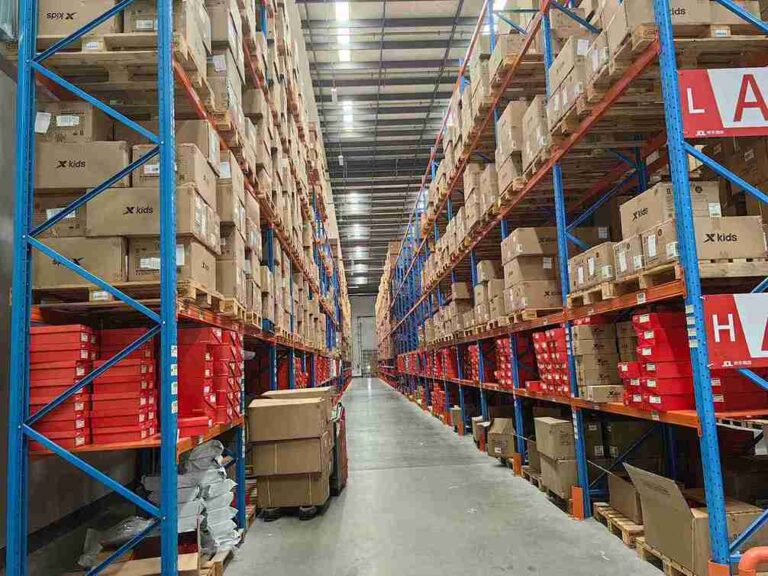📐 "First 50 Enterprise Queries Get Custom 3D Warehouse Design" Plan

Introduction: Why Pallet Rack Beam Spacing is Critical for Your Warehouse
Pallet rack beam spacing isn’t just a technical detail—it’s the backbone of an efficient, safe, and high-performing warehouse. Whether a facility is storing automotive parts, pharmaceuticals, or retail goods, proper pallet rack beam spacing ensures:
✔ Maximum storage density without wasted vertical space
✔ Safe load distribution to prevent rack collapses
✔ Smooth forklift operations with adequate clearance
✔ Compliance with OSHA and RMI safety standards
This guide dives deep into pallet rack beam spacing, offering actionable insights for warehouse managers, logistics planners, and safety inspectors. By the end, readers will know exactly how to optimize beam spacing for their specific needs—boosting efficiency while reducing risks.

The Science Behind Pallet Rack Beam Spacing
1. How Beam Spacing Affects Load Capacity
Every pallet rack beam spacing decision impacts weight distribution. If beams are spaced too far apart:
- Pallets may sag or collapse under heavy loads.
- Forklift operators struggle with unstable placements.
- The risk of racking system failure increases.
Conversely, spacing beams too close together:
- Wastes vertical storage space.
- Limits flexibility for different pallet sizes.
- Increases costs with unnecessary beam installations.
Key Takeaway: The ideal pallet rack beam spacing balances load capacity, accessibility, and space efficiency.
2. Industry Standards for Pallet Rack Beam Spacing
Most warehouses follow these general pallet rack beam spacing guidelines:
| Pallet Type | Recommended Beam Spacing |
|---|---|
| Standard (48×40″) | 42″ – 48″ apart |
| Euro Pallets (800x1200mm) | 32″ – 40″ apart |
| Oversized Pallets | 54″ – 72″ apart |
However, these are just starting points. The exact pallet rack beam spacing depends on:
- Pallet height & overhang
- Forklift clearance requirements
- Beam load capacity ratings
Pro Tip: Always consult the rack manufacturer’s load tables before finalizing spacing.
Step-by-Step Guide to Calculating Pallet Rack Beam Spacing
3. Measuring Pallet Dimensions Correctly
Before setting pallet rack beam spacing, warehouse managers must:
- Measure the tallest pallet (including overhang).
- Add 4-6 inches of clearance for forklift operations.
- Check for uneven weight distribution (e.g., top-heavy loads).
Example Calculation:
- Pallet height: 50″
- Required clearance: 6″
- Optimal pallet rack beam spacing: 56″
4. Using Load Capacity Charts for Precision
Manufacturers provide beam load charts that specify:
✔ Maximum weight per level at different spacings
✔ Deflection limits (how much beams can bend safely)
✔ Safety margins to prevent overloading
Critical Rule: Never exceed 85% of the beam’s rated capacity to account for dynamic loads.
Common Pallet Rack Beam Spacing Mistakes (And How to Fix Them)
5. Mistake #1: Ignoring Forklift Clearance Needs
Problem: If pallet rack beam spacing doesn’t account for forklift masts, operators may:
- Damage beams while lifting pallets.
- Struggle with tight maneuvers, slowing operations.
Solution: Always maintain at least 6″ of overhead clearance per level.
6. Mistake #2: Using One-Size-Fits-All Spacing
Problem: Warehouses storing mixed pallet sizes suffer from:
- Wasted space with fixed beam positions.
- Inaccessible inventory due to poor spacing.
Solution: Use adjustable pallet racking (APR) for flexible beam spacing.
7. Mistake #3: Overlooking Future Storage Needs
Problem: Fixed pallet rack beam spacing limits adaptability when:
- New pallet sizes are introduced.
- Storage density needs to increase.
Solution: Design racks with 10-15% extra adjustability for future changes.
Advanced Strategies for Optimizing Pallet Rack Beam Spacing
8. Selective vs. Double-Deep Racking: Which Needs Tighter Spacing?
- Selective racking (single-deep) allows tighter pallet rack beam spacing (42″-48″).
- Double-deep racking requires wider spacing (54″-60″) for forklift reach.
9. Push-Back & Drive-In Racking: Special Spacing Requirements
- Push-back racks need reinforced beams due to dynamic loads.
- Drive-in racks require closer beam spacing to prevent pallet shifts.
10. How Warehouse Management Systems (WMS) Optimize Spacing
Modern WMS software can:
✅ Simulate different pallet rack beam spacing layouts
✅ Track real-time load distribution
✅ Alert managers to overcapacity risks
Conclusion: Perfecting Pallet Rack Beam Spacing for Peak Efficiency
Optimizing pallet rack beam spacing is a science and an art. By following industry best practices, calculating precise measurements, and avoiding common pitfalls, warehouses can:
- Increase storage capacity by 15-30%
- Reduce safety incidents related to rack failures
- Improve forklift efficiency and throughput
For further guidance, consult:
- RMI’s Pallet Rack Safety Guidelines
- OSHA’s Warehouse Compliance Standards
Frequently Asked Questions (FAQs)
1. What’s the minimum vertical clearance needed for pallet rack beam spacing?
A minimum of 4-6 inches above the pallet is recommended for safe forklift operations.
2. Can I adjust beam spacing without dismantling the entire rack?
Yes, adjustable pallet racks (APR) allow for easy beam spacing modifications.
3. How does beam spacing affect seismic-rated racks?
Seismic zones require tighter pallet rack beam spacing (closer intervals) for added stability.
4. What beam spacing is best for storing heavy machinery parts?
Heavy loads require closer beam spacing (36″-42″) and higher-capacity beams.
5. Does cold storage affect pallet rack beam spacing requirements?
Yes, cold environments may need reinforced beams due to metal brittleness at low temperatures.




